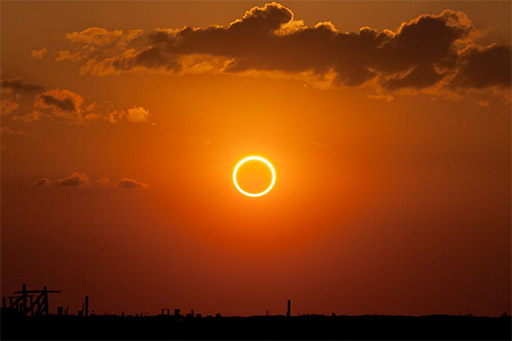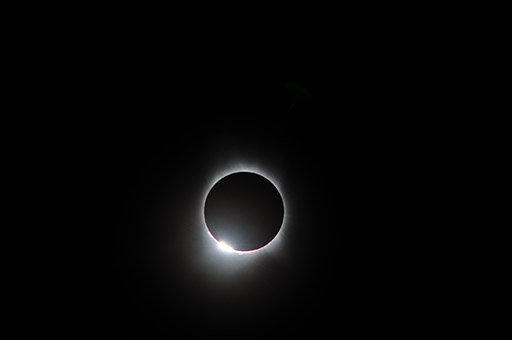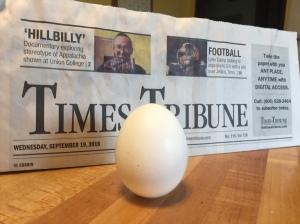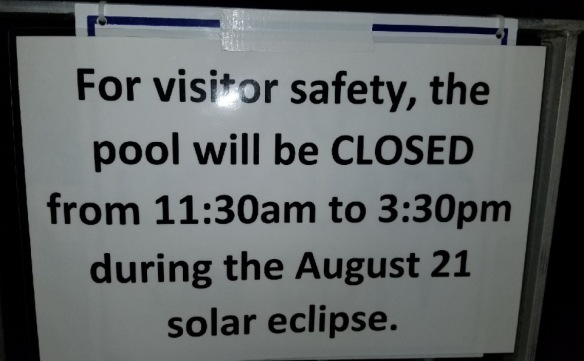
NOT a fake image. Photo by the author. ©2017 Mark Alsip.
After the “Great American Eclipse” of April 8, 2024, social media and the Internet have become swamped with highly-manipulated and/or completely fake images of totality. As an eclipse chaser with 26 years experience under my belt, I’m greatly disturbed by this. Total eclipses of the sun are the most beautiful events in nature. There’s absolutely no need to falsify how they look.
In this edition of Bad Science Debunked, I’d like to take in-depth looks at a couple of the most popular fake or manipulated images. I’ll explain how we know they aren’t real (or are manipulated). I’ll talk about why some photographers manipulate their images, how such images are sometimes hijacked without the photographer’s permission, and look at both the good and bad that can come from such manipulation.
Artificial Intelligence Rears It’s Head
Let’s start with the photo below.6 In a moment I’ll talk about the impossibility of capturing the wide dynamic range of light in the various parts of the the sun’s corona (atmosphere) seen in this image, but alarm bells were already going off in my head just based on knowing something about the April 8, 2024 eclipse.
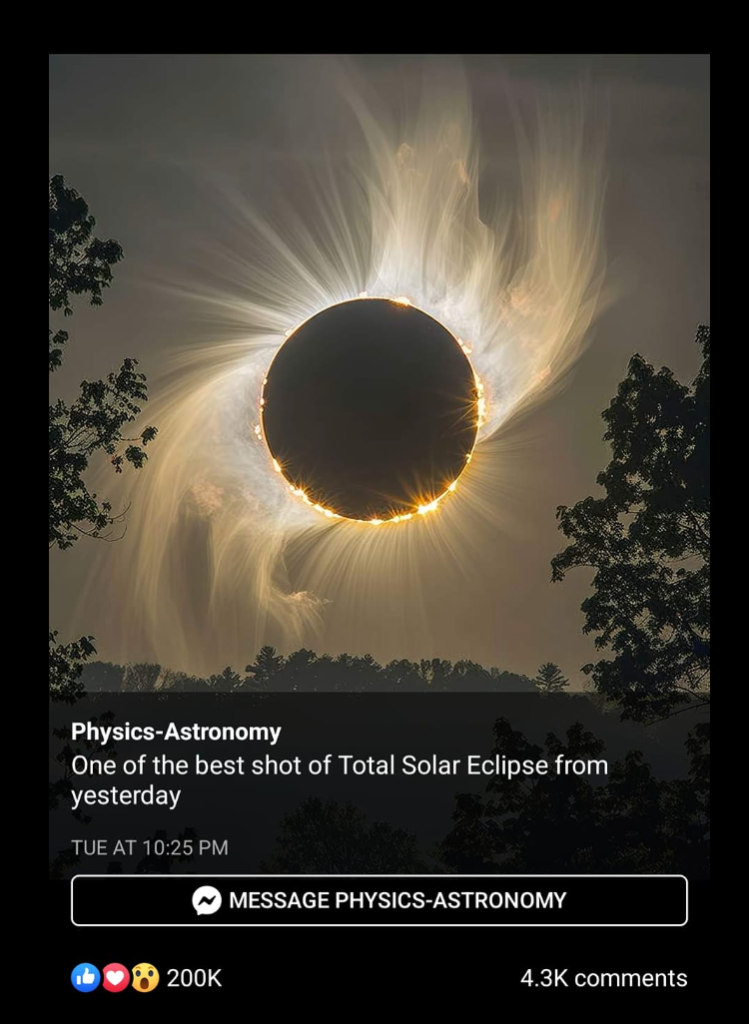
Image Credit: author unknown, please see photo credits at end of article for attribution and declaration of usage rights.
First, notice the sunset/sunrise colors in the photo. Notice how close to the horizon the moon and sun are. This simply wasn’t possible on April 8. The eclipse began at sea southwest of Mexico, so there would’ve been no land from which to shoot a sunrise shot. Likewise, the eclipse ended over land in the North Atlantic. Again, there would be no land-based position from which to shoot a sunrise or sunset photo.
Second, look at all the little golden beads and “swirls” around the edge of the sun. The beads are known as Bailey’s Beads. These “beads” are small glints of sunlight shining through mountain passes on the limb of the moon. The swirls that seem to leap off the sun are called “prominences.” Prominences are large masses of gas leaping off the surface of the sun.
To see so much of this phenomena literally 360 degrees around the sun would have required what’s known as a “shallow eclipse.” The moon would have needed to be far enough from Earth to just-ever-so-slightly cover the face of the sun, allowing so many beads and prominences to be visible. I was clouded out on April 8, but I’ve looked at a great deal of photographs from those who weren’t, and the eclipse just wasn’t this shallow. Nor was it expected to be. Look at some legitimate images of this eclipse from NASA and you’ll see the difference.1
Third, notice what appears to be full foliage on deciduous trees. For this to have been a sunset image, it would have had to been taken at a high latitude. The eclipse left land for good near tiny Bonavista, Newfoundland & Labrador, just north of St. John’s, Newfoundland2, at a latitude of 48 degrees north. With the foliage just now thickening near my home of Lexington, KY, a full 10 degrees farther south, I find it incredible to believe the trees are this far advanced 10 degrees to the north.
Worse yet, the eclipse ended in BonaVista at 4:30pm local time on April 8. The sun would not set there until over three hours later (7:44pm local time).
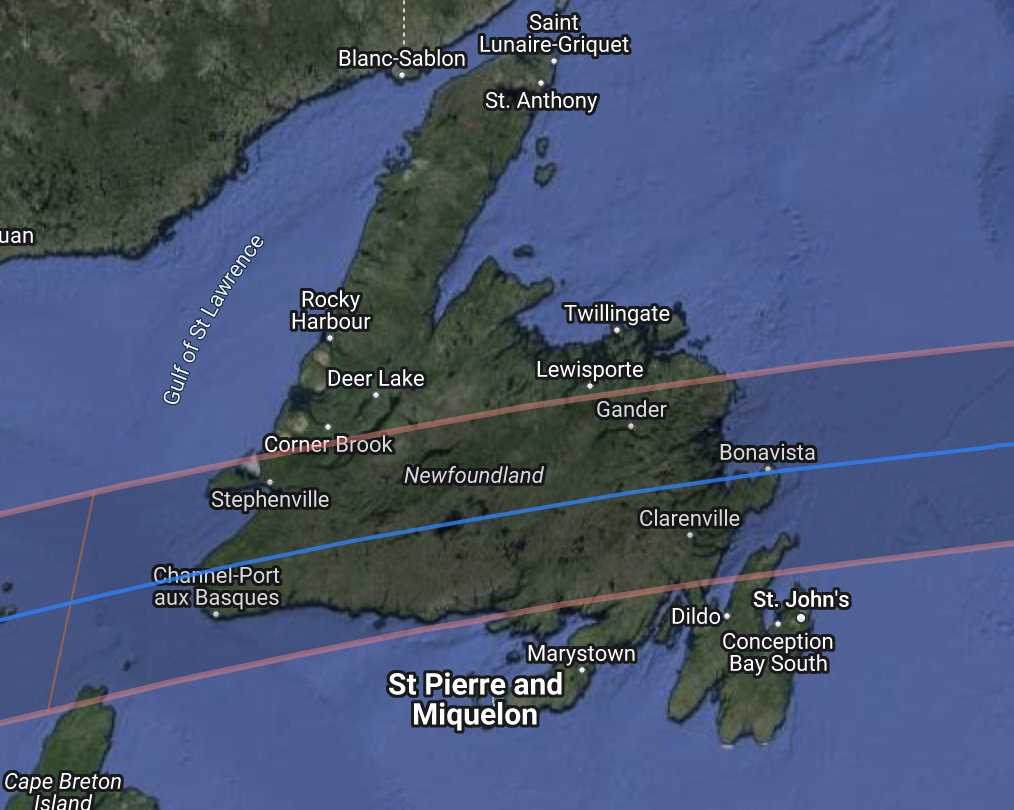
The eclipse leaves land for good in Newfoundland, with totality ending at 4:30pm, three hours before sunset.2 Map courtesy Javier M. Xubier/Google Maps.
Things don’t get any better for the possibility of a sunrise photo. Aside from a minor island, the eclipse first touched land near Mazatlan, Mexico.3 The sun rose at 5:51am in Mazatlan on eclipse day, but totality didn’t end until 11:11am local time. That’s about five hours after the sun first touched Mazatlan’s beaches. There was no possibility of taking a sunrise picture of the eclipse in Mexico on April 8, even though the country would have the foliage.
So, this image was not taken at sunrise or sunset, anywhere in the path of the eclipse, despite the very clear colors indicating this would be the case.

The eclipse comes ashore near the resort city of Mazatlan, Mexico, where totality ended at 11:11am local time.3 The sun rose a full 5 hours earlier, at 5:51am local time. Map courtesy Javier M. Xubier/Google Maps.
AI Generated? Yes, Most Likely
Being unable to track down any source for this photo to learn how it was produced, I followed the suggestion of the Facebook page Exploiting the Niche,10 which has a thread dedicated to solar eclipse photo fakes. The suggestion? Run the image through an analysis tool designed to look for AI-generated fakes. I used the free Hive9 plugin for Chrome. This is what I found:
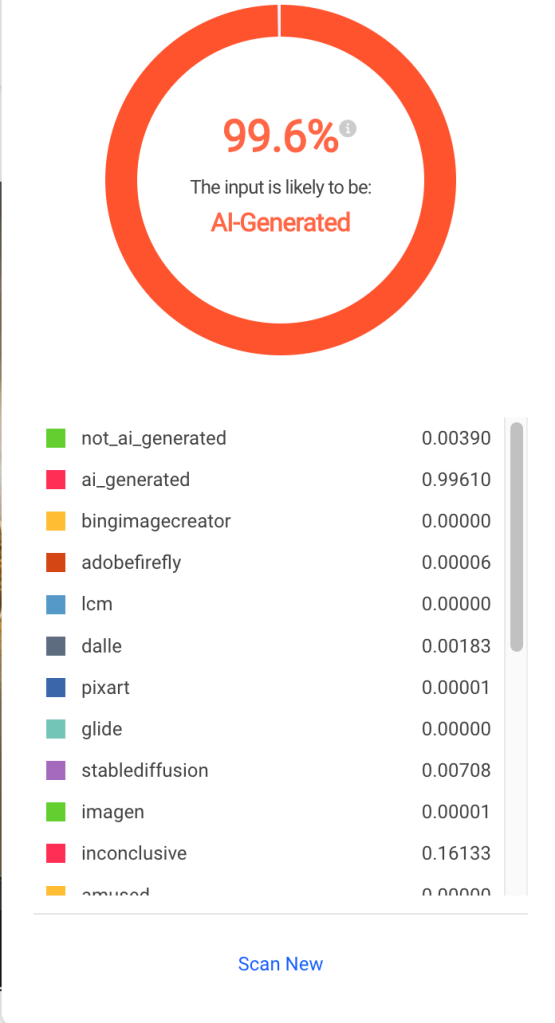
In contrast, let’s run the Hive9 detector on my own image, the un-retouched feature image for this story:
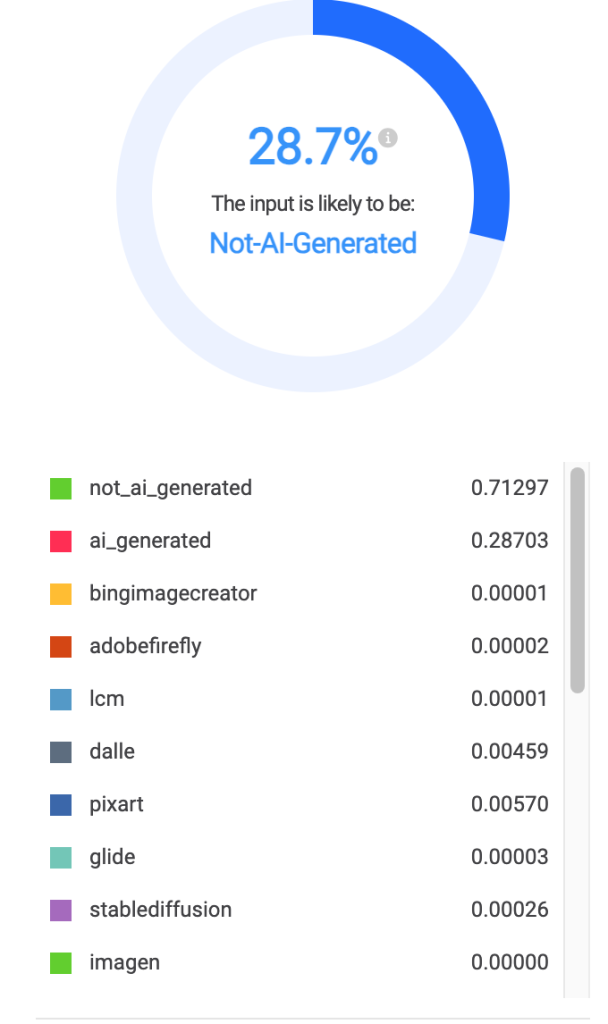
Case #2: Clear and Obvious Image Manipulation
Let’s turn our attention now to another highly modified image which, again, in no way represents what totality actually looks like. This hijacked image was shared very widely, including the Facebook sites “Science Updates” and the fake “James Webb Space Telescope”5 (has nothing to do with the real JWST) page:
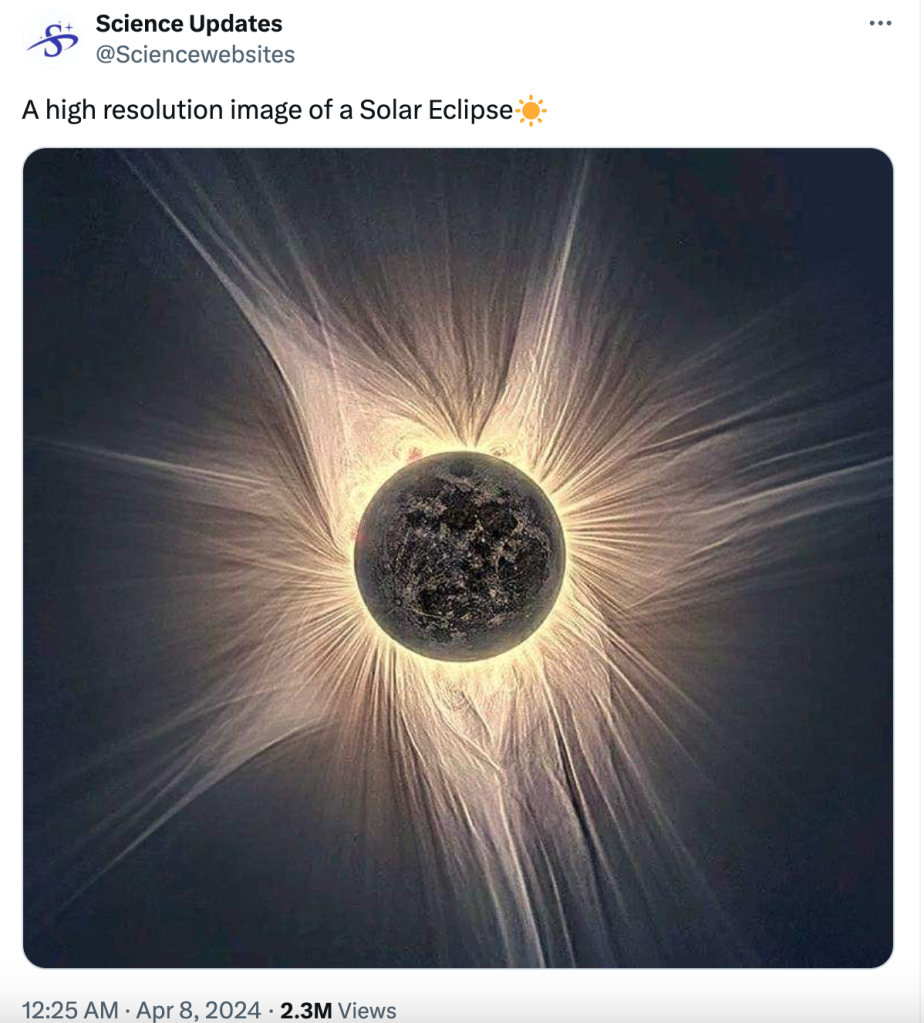
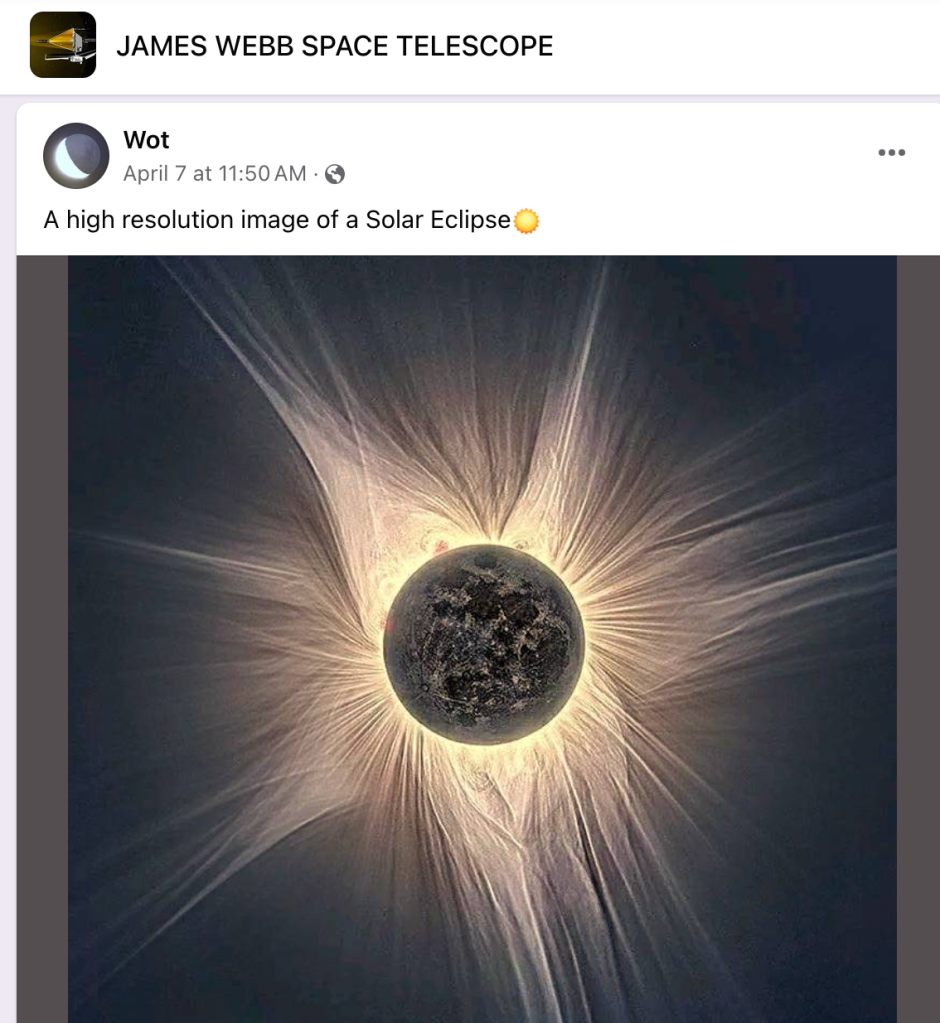
The fake JWST page blocked me when I pointed out they were sharing a misleading image:

The fake JWST Facebook page won’t allow dissenting comments, pointing out the problems with the image they hijacked.
There’s a little more information on this image than was available for the previous one. A reverse image search on Google first led me to the Twitter/X page of Dr. Sebastian Voltmer, from who, it turns out, the image was hijacked.
Dr. Sebastian Voltmer’s Twitter/X page7 says he does High Dynamic Range (HDR) solar eclipse photography:
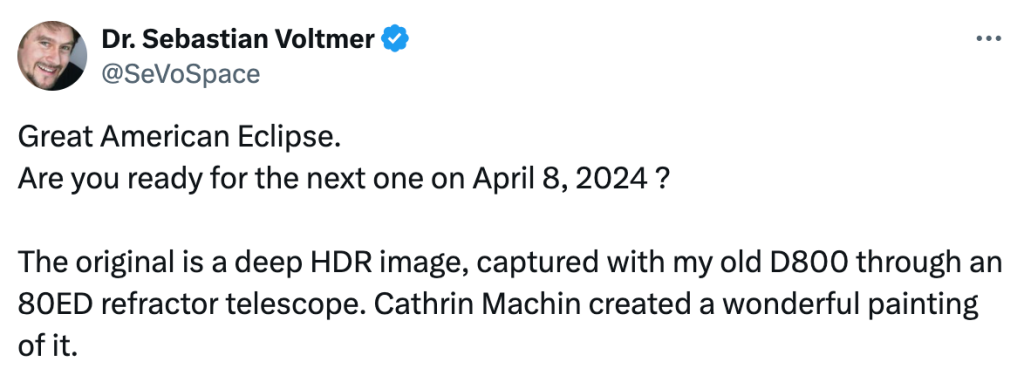
The comment above refers to a photo he took in 2017. Before I dive into his 2024 photo, the one that’s causing all the controversy right now, let me explain what HDR photography is, and what it is not.
HDR photos are not “high resolution” photos, as they’re so often mislabeled. Instead, they are digitally enhanced pictures that use software to make up for the fact that even modern cameras cannot possibly capture the wide range (the “R” in “HDR”) of brightness found in various features of the eclipse.
For example, look closely at the surface of the moon in the previous Photoshopped eclipse photo. See all that detail? It’s visible–but only just so–because of light reflected back from Earth onto the face of the moon. To capture any type of detail from the very dim light of “earthshine” takes very long exposures… in my experience one second or longer.
Contrast this vastly greater brightness of features such as the “diamond ring,” Bailey’s Beads, or the inner corona (the milky-white atmosphere of the sun, “inner” referring to the part of the sun’s atmosphere closest to our star’s surface). Here’s we’re talking exposure times much shorter than a second… perhaps 1/500th to 1/125th of a second. This is all well and good for the features we want to record, but unfortunately this exposure time is way too short to capture any detail on the face of the moon, made possible by the dim earthshine. The difference is too vast.
As we step away from the sun, the corona (again, this is the sun’s atmosphere) is less bright. To properly expose this region of the solar atmosphere, we must resort to longer exposure times, perhaps 1/60th to 1/30th of a second. Notice we’re doubling to quadrupling the time needed to get detail in the inner corona. But (there’s always a “but,” isn’t there?) now that we get nice detail in the mid-corona, the inner corona becomes washed out. It’s just too bright.
By the time we get all the way to the outer corona, farthest away from the sun, we’re back in the neighborhood of 1/30th to 1/8th of a second, or even a full second. Look again at the manipulated photo… see all those delicate “streamers” far away from the sun? They’re captured with slow shutter speeds which, to beat a dead horse here, totally washes out both the inner and mid parts of the corona. Those features lose detail, turning into a white blob.
I’ll illustrate using my own photography, looking at three parts of the range, including the most extreme. In each case, all my camera settings are the same. I’m only changing the exposure time, letting in more light with each shot, in order to capture different parts of the eclipse.
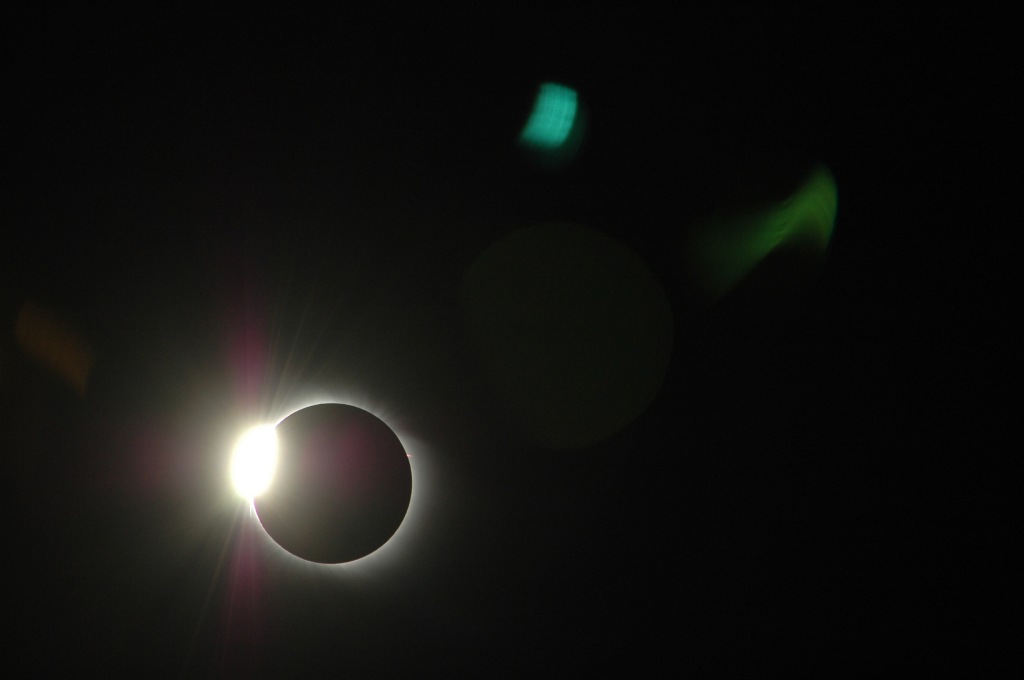
A diamond ring, the very inner corona, and a red prominence (the ruby-red dot) at two-o’clock. ISO 200, F/8, 1/250 second. Green spots are lens flare (internal reflections in the glass of my lens). Photo by the author. ©2017 Mark Aaron Alsip.
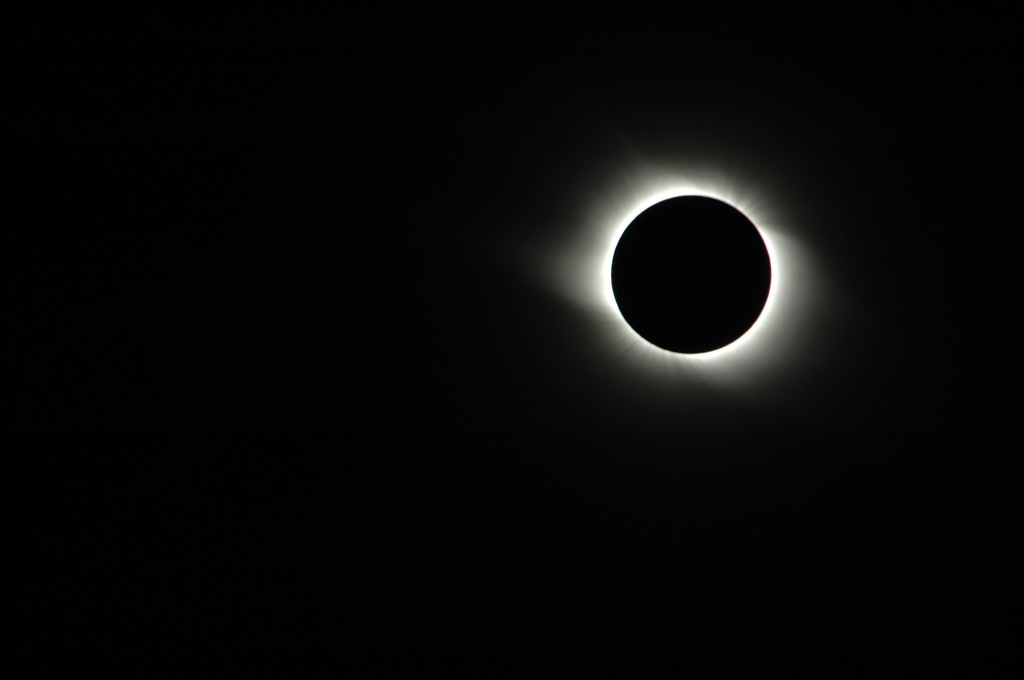
“Mid” corona. Notice detail farther from the sun, but pay attention to the fact that detail in the inner corona, visible in the previous shot, is now wiped out due to the difference in brightness. ISO 200, F/8, 1/60 second. Photo by the author. ©2017 Mark Aaron Alsip.
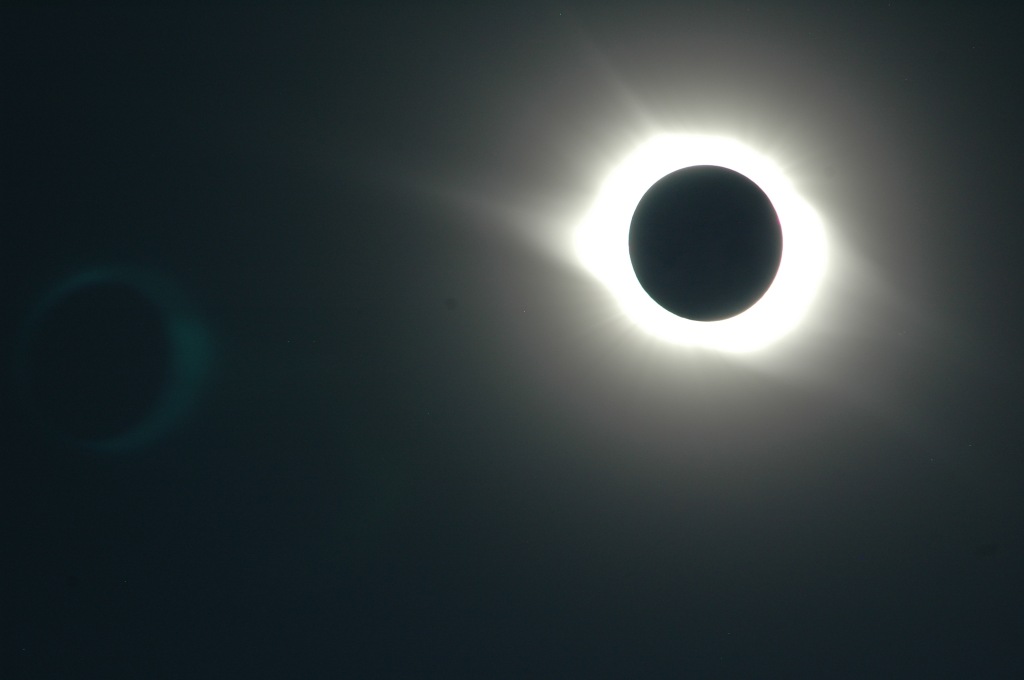
Outer corona. Notice some detail appearing very far from the sun… detail that couldn’t be seen in the previous photos because the exposure wasn’t long enough. But notice how the inner and mid corona are completely wiped out. And even at this slow speed, we’re still not picking up enough light to show detail on the moon from earthshine. ISO 200, F/8, 1/2 second. Photo by the author. ©2017 Mark Aaron Alsip.
So at this point, you might be saying… “Hey, wait a minute! I’ve seen total eclipses before and much more detail was visible to me, through all parts of the wide range you’re showing here!”
And you’d be absolutely correct. Our eyes and brains are much more sophisticated than our cameras. When we look at an eclipse, these organs work together to process the incredible dynamic range of the lighting.
Read that last paragraph again please. When you look at the fanciful, admittedly-beautiful photographs showing fine detail in all parts of the corona, you are looking at deliberate manipulations made by the photographer in an attempt to recreate what he/she saw with their own eyes.
There’s nothing inherently wrong with this! I’ve played around with the technique myself.
The problem, in my humble opinion, is that sometimes photographers go too far. I can’t say for certain what another person believes they have seen, and I accept that artistic license is involved in the attempt to invoke how it felt to witness totality. I respectfully submit that the photographer, and all who reproduce the photographer’s work, should be very clearly labelling the images as manipulated.
To his great credit, Dr. Sebastian Voltmer, whose work has been hijacked by unscrupulous or unaware web sites, does explain exactly what he’s doing. He even posted a disclaimer on his Twitter/X page about the misrepresentation of his work:8
HDR eclipse image by Dr. Sebastian Voltmer. ©2024 Dr. Sebastian Voltmer. See image credits at article’s end for disclaimer on usage rights under fair use laws.
While clearly a stunning piece of art, to a seasoned eclipse chaser, this just is not reality. Presented out of context, which others have done without Dr. Voltmer’s permission or knowledge, the image could mislead the public into believing eclipses really look this way. They are already the most beautiful event in nature. There’s no need to misrepresent them by hijacking someone else’s work. This can set high, false expectations in the public’s mind.
So How’s It Done?
Describing the various methods of producing HDR eclipse images is beyond the scope of this article. If you’re interested in learning more, you can find great reference material on the web, including this primer by Sky & Telescope Magazine.4
In a nutshell, there are a couple techniques I can briefly describe.
The first, and perhaps the most common, is to do what I showed earlier: take multiple images of the eclipse at various exposure settings, then “stack” them all together in a program like Photoshop, and apply a special High Dynamic Range filter to the image stack to achieve the desired result. One old trick that really makes the streaming corona “pop” is to use Photoshop’s “emboss” filter to create a masking layer that can then be used to artificially create detail that isn’t really there in the original image.
More than you want to know if you’re not a photographer: Many photographers now shoot in “raw” mode, rather than simply capturing images as jpegs like simple consumer cameras and phones will do. Raw image data preserves much more information about the original photo than a jpeg, which, due to being a compression algorithm, must necessarily throw away information you can never get back. As described in the linked Sky and Telescope article4, one can shoot a single raw image and pull out details through various tweaking.
It’s all up to the photographer. Photography is art, but it’s also an important scientific tool. As long as the photographer makes an effort to disclose manipulation, and, importantly, the public who consume and pass along the work maintain this disclosure, there aren’t any problems.
References
(1) The 2024 Eclipse Through the Eyes of NASA
https://science.nasa.gov/solar-system/skywatching/april-8-total-solar-eclipse-through-the-eyes-of-nasa/
Retrieved 12 Apr 2024
(2) Eclipse Path Over Newfoundland, Map Courtesy Xavier M. Jubier/Google Maps
http://xjubier.free.fr/en/site_pages/solar_eclipses/TSE_2024_GoogleMapFull.html?Lat=48.66416&Lng=-53.07724&Elv=26.0&Zoom=6&LC=1
Retrieved 12 Apr 2024
This map image is used in accordance with Title 17 U.S.C. Section 107, commonly known as “fair use law”. This material is distributed without profit with the intent to provide commentary, review, education, parody, and increase public health knowledge.
(3) Eclipse path over Mazatlan, Mexico, Map Courtesy Xavier M. Jubier/Google Maps
http://xjubier.free.fr/en/site_pages/solar_eclipses/TSE_2024_GoogleMapFull.html?Lat=23.08103&Lng=-106.24692&Elv=4.0&Zoom=8&LC=1
Retrieved 12 Apr 2024
This map image is used in accordance with Title 17 U.S.C. Section 107, commonly known as “fair use law”. This material is distributed without profit with the intent to provide commentary, review, education, parody, and increase public health knowledge.
(4) Eclipse Photography: Reveal Totality in HDR (Sky & Telescope, 15 Mar 2020)
https://skyandtelescope.org/astronomy-resources/astrophotography-tips/revealing-totality-in-hdr/
Retrieved 12 Apr 2024
(5) “James Webb Space Telescope” (Warning: fake page. Not associated with the real JWST or NASA)
https://www.facebook.com/groups/203565655155826/
Retrieved 12 Apr 2024
This image is used in accordance with Title 17 U.S.C. Section 107, commonly known as “fair use law”. This material is distributed without profit with the intent to provide commentary, review, education, parody, and increase public health knowledge.
(6) “Physics-Astronomy” “sunset eclipse” (Warning: Most likely AI generated. Not how an eclipse looks! Dubious web site. Many faked/altered images found)
https://www.facebook.com/physicsdashastronomy
Retrieved 12 Apr 2024
This image is used in accordance with Title 17 U.S.C. Section 107, commonly known as “fair use law”. This material is distributed without profit with the intent to provide commentary, review, education, parody, and increase public health knowledge.
(7) Deep High Dynamic Range Photograph of Totality, by Dr. Sebastian Voltmer
https://twitter.com/SeVoSpace/status/1776379193678582041
Retrieved 12 Apr 2024
Dr. Voltmer’s image is used in accordance with Title 17 U.S.C. Section 107, commonly known as “fair use law”. This material is distributed without profit with the intent to provide commentary, review, education, parody, and increase public health knowledge.
(8) Dr. Sebastian Voltmer Sets the Record Straight
https://x.com/sevospace/status/1526185965995311105?s=46
Retrieved 13 Apr 2024
Dr. Voltmer’s image is used in accordance with Title 17 U.S.C. Section 107, commonly known as “fair use law”. This material is distributed without profit with the intent to provide commentary, review, education, parody, and increase public health knowledge.
(9) Hive AI-detection plugin for Chrome
https://hivemoderation.com/ai-generated-content-detection
Retrieved 12 Apr 2024
(10) Exploiting the Niche (Facebook)
https://www.facebook.com/ExploitingTheNiche
Retrieved 13 Apr 2024
Other Image Credits
Images attributed to the author, ©2017 Mark Aaron Alsip. All rights reserved.



